Freshwater snail


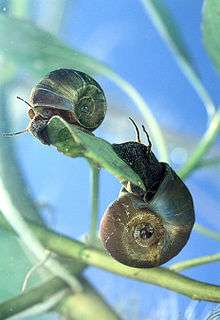
Freshwater snails are gastropod mollusks which live in freshwater. There are many different families. They are found throughout the world in various habitats, ranging from ephemeral pools to the largest lakes, and from small seeps and springs to major rivers. The great majority of freshwater gastropods have a shell, with very few exceptions. Some groups of snails that live in freshwater respire using gills, whereas other groups need to reach the surface to breathe air. Most feed on algae, but many are detritivors and some are filter feeders.
According to a 2008 review of the taxonomy, there are about 4,000 species of freshwater gastropods (3,795-3,972).[1]
At least 33–38 independent lineages of gastropods have successfully colonized freshwater environments.[2] It is not possible to quantify the exact number of these lineages yet, because they have yet to be clarified within the Cerithioidea.[2] From six to eight of these independent lineages occur in North America.[3]
Taxonomy
2005 taxonomy
The following cladogram is an overview of the main clades of gastropods based on the taxonomy of Bouchet & Rocroi (2005),[4] with families that contain freshwater species marked in boldface:[1] (Some of the highlighted families consist entirely of freshwater species, but some of them also contain, or even mainly consist of, marine species.)
| |||||||||||||||||||||||||||||||||||||||||||||||||||||||||||||||||||||||||||||||||||||||||||||||||
2010 taxonomy
The following cladogram is an overview of the main clades of gastropods based on the taxonomy of Bouchet & Rocroi (2005),[4] modified after Jörger et al. (2010)[5] and simplified with families that contain freshwater species marked in boldface:[1] (Marine gastropods (Siphonarioidea, Sacoglossa, Amphiboloidea, Pyramidelloidea) are not depicted within Panpulmonata for simplification. Some of these highlighted families consist entirely of freshwater species, but some of them also contain, or even mainly consist of, marine species.)
| |||||||||||||||||||||||||||||||||||||||||||||||||||||||||||||||||||||||||||||||||||||||||||
Neritimorpha
The Neritimorpha are a group of primitive "prosobranch" gilled snails which have a shelly operculum.
- Neritiliidae, 5 extant freshwater species[1]
- Neritidae, largely confined to the tropics, also the rivers of Europe, family includes the marine "nerites".[6] There are about 110 extant freshwater species.[1]
 Family Neritidae, shells of Theodoxus fluviatilis.
Family Neritidae, shells of Theodoxus fluviatilis. Family Neritidae, Neritina natalensis
Family Neritidae, Neritina natalensis
Caenogastropoda
The Caenogastropoda are a large group of gilled operculate snails, which are largely marine. In freshwater habitats there are ten major families of caenogastropods, as well as several other families of lesser importance:
- Architaenioglossa
- Ampullariidae, an exclusively freshwater family that is largely tropical and includes the large "apple snails" kept in aquaria.[6] 105-170 species.[1]
- Viviparidae, medium to large snails, live-bearing, commonly referred to as "mystery snails". Worldwide except South America, and everywhere confined to fresh waters.[6] 125-150 species.[1]
 Family Ampullariidae, Pomacea bridgesii.
Family Ampullariidae, Pomacea bridgesii.- Family Viviparidae, Viviparus viviparus.
- Sorbeoconcha
- Melanopsidae, family native to rivers draining to the Mediterranean, also Middle East, and some South Pacific islands.[6] About 25-50 species.[1]
- Pachychilidae - 165-225 species.[1] native to South and Central America. Formerly included with the Pleuroceridae by many authors.
- Paludomidae - about 100 species in south Asia, diverse in African Lakes, and Sri Lanka.[1] Formerly classified with the Pleuroceridae by some authors.
- Pleuroceridae, abundant and diverse in eastern North America, largely high-spired snails of small to large size.[6] About 150 species.[2]
- Semisulcospiridae, - primarily eastern Asia, Japan, also the Juga snails of northwestern North America. Formerly included with the Pleuroceridae. About 50 species.[2]
- Thiaridae, high-spired parthenogenic snails of the tropics, includes those referred to as "trumpet snails" in aquaria.[6] About 110 species.[2]
 Family Pleuroceridae, Io fluvialis.
Family Pleuroceridae, Io fluvialis. Family Semisulcospiridae, Semisulcospira kurodai.
Family Semisulcospiridae, Semisulcospira kurodai.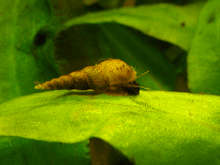 Family Thiaridae, Melanoides tuberculata.
Family Thiaridae, Melanoides tuberculata.
- Littorinimorpha
- Littorinidae - 9 species in the genus Cremnoconchus are freshwater living in streams and waterfalls.[7] Other species are marine.
- Amnicolidae - about 200 species.[1]
- Assimineidae - about 20 freshwater species,[1] other are marine
- Bithyniidae, small snails, native to Eastern Hemisphere.[6] About 130 species.[1]
- Cochliopidae - 246 species.[1]
- Helicostoidae, the only species Helicostoa sinensis lives in China.[1]
- Hydrobiidae, small to very small snails found worldwide.[6] About 1250 freshwater species[1] other are marine.

- Lithoglyphidae - about 100 species.[1]
- Moitessieriidae - 55 species.[1]
- Pomatiopsidae, small amphibious snails scattered worldwide, most diverse in eastern and Southeast Asia.[6] About 170 species.[1]
- Stenothyridae - about 60 freshwater species,[1] others are marine.
- Neogastropoda
- Buccinidae - 8-10 freshwater species in the genus Clea,[1] native to Southeast Asia. Other Buccinidae are marine.
- Marginellidae - 2 freshwater species in the genus Rivomarginella,[1] native to Southeast Asia. Other Marginellidae are marine.
Heterobranchia

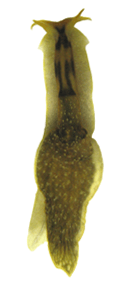
- Lower Heterobranchia
- Glacidorbidae - 20 species.[1]
- Valvatidae, small low-spired snails referred to as "valve snails". 71 species.[1]
- Acochlidiidae (including synonym Strubelliidae) - 5 shell-less species:[1] Acochlidium amboinense, Acochlidium bayerfehlmanni, Acochlidium fijiiensis, Palliohedyle sutteri and Strubellia paradoxa[8]
- Tantulidae - there is only one species[1] which is shell-less Tantulum elegans.
- Pulmonata, Basommatophora
Basommatophorans are pulmonate or air-breathing aquatic snails, characterized by having their eyes located at the base of their tentacles, rather than at the tips, as in the true land snails Stylommatophora. The majority of basommatophorans have shells that are thin, translucent, and relatively colorless, and all five freshwater basommatophoran families lack an operculum.
- Chilinidae, small to medium-sized snails confined to temperate and cold South America.[6] About 15 species.[1]
- Latiidae, small limpet-like snails confined to New Zealand.[6] One[1] or three species.
- Acroloxidae - about 40 species.[1]
- Lymnaeidae, found worldwide, but are most numerous in temperate and northern regions.[6] These are the dextral (right-handed) pond snails. About 100 species.
- Planorbidae, "rams horn" snails, with a worldwide distribution.[6] About 250 species.[1]
- Physidae, left-handed (sinistral) "pouch snails", native to Europe, Asia, North America.[6] About 80 species.[1]
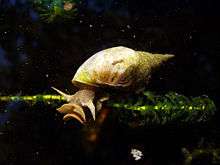 Family Lymnaeidae, Lymnaea stagnalis.
Family Lymnaeidae, Lymnaea stagnalis.- Family Physidae, Physella acuta.
 Family Planorbidae, Planorbarius corneus.
Family Planorbidae, Planorbarius corneus.
As human food
Several different freshwater snail species are eaten in Asian cuisine.
Archaeological investigations in Guatemala have revealed that the diet of the Maya of the Classic Period (AD 250-900) included freshwater snails.[9]
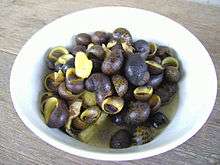
 A Bengali dish of stir-fried freshwater snails with onion and garlic paste and other spices, from Kolkata, West Bengal, India
A Bengali dish of stir-fried freshwater snails with onion and garlic paste and other spices, from Kolkata, West Bengal, India
Aquarium snails
In the developed world, people encounter freshwater snails most commonly in aquaria along with tropical fish. Species available vary in different parts of the world. In the United States, commonly available species include ramshorn snails such as Planorbella duryi, apple snails such as Pomacea bridgesii, the high-spired thiarid malaysian trumpet snail Melanoides tuberculata, and several Neritina species.
Parasitology
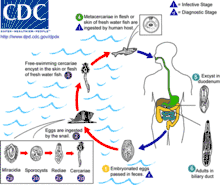
Freshwater snails are widely known to be hosts in the lifecycles of a variety of human and animal parasites, particularly trematodes or "flukes". Some of these relations for prosobranch snails include Oncomelania in the family Pomatiopsidae as hosts of Schistosoma, and Bithynia, Parafossarulus and Amnicola as hosts of Opisthorchis.[10] Thiara and Semisulcospira may host Paragonimus.[10] Juga plicifera may host Nanophyetus salmincola.[11] Basommatophoran snails are even more widely infected, with many Biomphalaria (Planorbidae) serving as hosts for Schistosoma mansoni, Fasciolopsis and other parasitic groups.[10] The tiny Bulinus snails are hosts for Schistosoma haematobium.[10] Lymnaeid snails (Lymnaeidae) serve as hosts for Fasciola and the cerceriae causing swimmer's itch.[10] The term “neglected tropical diseases” applies to all snail-borne infections, including schistosomiasis, fascioliasis, fasciolopsiasis, paragonimiasis, opisthorchiasis, clonorchiasis, and angiostrongyliasis.[12]
See also
References
This article incorporates CC-BY-2.5 text from the reference[12]
- 1 2 3 4 5 6 7 8 9 10 11 12 13 14 15 16 17 18 19 20 21 22 23 24 25 26 27 28 29 30 31 Strong E. E., Gargominy O., Ponder W. F. & Bouchet P. (2008). "Global Diversity of Gastropods (Gastropoda; Mollusca) in Freshwater". Hydrobiologia 595: 149-166. hdl.handle.net doi:10.1007/s10750-007-9012-6.
- 1 2 3 4 5 Strong E. E., Colgan D. J., Healy J. M., Lydeard C., Ponder W. F. & Glaubrecht M. (2011). "Phylogeny of the gastropod superfamily Cerithioidea using morphology and molecules". Zoological Journal of the Linnean Society 162(1): 43-89. doi:10.1111/j.1096-3642.2010.00670.x.
- ↑ Dillon R. T. (2006). Chapter 21. Freshwater Gastropoda. pages 251-259. In: Sturm C. F., Pearce T. A. & Valdés A. (eds.) (2006). The Mollusks: A Guide to Their Study, Collection, and Preservation. American Malacological Society, 445 pp. ISBN 978-1-58112-930-4.
- 1 2 Bouchet P.; Rocroi J.-P.; Frýda J.; Hausdorf B.; Ponder W.; Valdés Á. & Warén A. (2005). "Classification and nomenclator of gastropod families". Malacologia: International Journal of Malacology. Hackenheim, Germany: ConchBooks. 47 (1-2): 1–397. ISBN 3-925919-72-4. ISSN 0076-2997.
- ↑ Jörger K. M., Stöger I., Kano Y., Fukuda H., Knebelsberger T. & Schrödl M. (2010). "On the origin of Acochlidia and other enigmatic euthyneuran gastropods, with implications for the systematics of Heterobranchia". BMC Evolutionary Biology 10: 323. doi:10.1186/1471-2148-10-323.
- 1 2 3 4 5 6 7 8 9 10 11 12 13 14 Banarescu P. (1990). Zoogeography of Fresh Waters, Vol. 1, General Distribution and Dispersal of Freshwater Animals. AULA - Verlag, Weisbaden.
- ↑ Reid D. G., Aravind N. A., & Madhyastha N. A. (2013). "A unique radiation of marine littorinid snails in the freshwater streams of the Western Ghats of India: the genus Cremnoconchus W.T. Blanford, 1869 (Gastropoda: Littorinidae)". Zoological Journal of the Linnean Society 167(1): 93-135. doi:10.1111/j.1096-3642.2012.00875.x.
- ↑ Schrödl M. & Neusser T. P. (2010). "Towards a phylogeny and evolution of Acochlidia (Mollusca: Gastropoda: Opisthobranchia)". Zoological Journal of the Linnean Society 158: 124-154. doi:10.1111/j.1096-3642.2009.00544.x.
- ↑ Foias A. E. (2000). "Entre la política y economía: Resultados preliminares de las primeras temporadas del Proyecto Arqueológico Motul de San José." (PDF online publication). XIII Simposio de Investigaciones Arqueológicas en Guatemala, 1999 (edited by J.P. Laporte, H. Escobedo, B. Arroyo and A.C. de Suasnávar) (in Spanish). Museo Nacional de Arqueología y Etnología, Guatemala: 771–799. Retrieved 2009-03-01., page 777.
- 1 2 3 4 5 Chandler A. C. & Read C P. (1961). Introduction to Parasitology. John Wiley and Sons, New York. 822 pp.
- ↑ Adams A. M. (2006). Foodborne trematodes. In: Ortega I. R. (ed.) (2006). Foodborne parasites. ISBN 0-387-30068-6. page 178.
- 1 2 Adema C. M., Bayne C. J., Bridger J. M., Knight M., Loker E. S., Yoshino T. P. & Zhang S.-M. (2012). "Will All Scientists Working on Snails and the Diseases They Transmit Please Stand Up?". PLoS Neglected Tropical Diseases 6(12): e1835. doi:10.1371/journal.pntd.0001835.
Further reading
- J. Mouthon, Typology of molluscs of flowing water; biotypological organisations; socioecological groupings; Annls Limnol. Volume 17, Number 2, 1981
- Haynes A. (2000). "The distribution of freshwater gastropods on four Vanuatu islands: Espiritu Santo, Pentecost, Éfate and Tanna (South Pacific)". Annales de Limnologie 36(2): 101-111. doi:10.1051/limn/2000006, PDF.
- Vermeij J. & Wesselingh F. P. (2002). "Neogastropod molluscs from the Miocene of western Amazonia, with comments on marine to freshwater transitions in molluscs". Journal of Paleontology 76(2): 265-270. doi:10.1666/0022-3360(2002)076<0265:NMFTMO>2.0.CO;2.
- >J.B. Burch, Freshwater snails of North America; 1982 - nepis.epa.gov